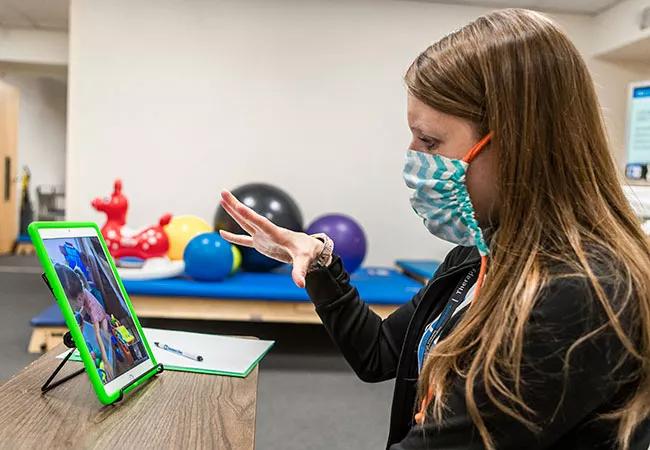Cleveland Clinic Children’s shares its learnings from the early days of COVID-19

This past spring, Lainie Holman, MD, a physiatrist at Cleveland Clinic Children’s Hospital for Rehabilitation, teamed with clinicians from Cleveland Clinic’s Epilepsy Center to conduct virtual consults about rehabilitation options for two pediatric postoperative patients.
Advertisement
Cleveland Clinic is a non-profit academic medical center. Advertising on our site helps support our mission. We do not endorse non-Cleveland Clinic products or services. Policy
“With the help of parents, nursing and the physician’s assistant, I was able to see the patients virtually, review their functional histories and make recommendations for postoperative rehabilitation level of care,” says Dr. Holman. “We were able to do all of this without exposing the patients, their families or the care teams to unnecessary physical interaction. It was also highly efficient in planning for a transfer of care.”
During the COVID-19 pandemic, Dr. Holman and her colleagues in the Department of Pediatric Physical Medicine and Rehabilitation have shifted much of their practice to telemedicine. “Rehabilitation is such a hands-on, team-oriented discipline,” she says. “The relationship between patients and physical therapists is very close. We’ve really been able to make the shift to telemedicine — and make it work — in a short period of time.”
Cleveland Clinic Children’s Hospital for Rehabilitation provides inpatient and outpatient care for patients with a variety of conditions. In the wake of COVID-19, inpatient services for those who require acute rehabilitation due to illness, injury, or complex medical or congenital conditions have changed significantly. Two notable modifications relate to rounding and family education.
Before the pandemic, the multidisciplinary pediatric rehabilitation team would conduct morning rounds as a group. Depending on the patient, members would include representatives from social work, occupational therapy, physical therapy, recreational therapy, speech therapy, nursing, psychology, medicine, care management and nutrition. “We’ve now changed to in-person rounding with just the core medical team — myself, the hospitalist, the nurse practitioner and the bedside nurse,” says Dr. Holman. “Everybody else joins via a virtual platform brought into the rooms on a mobile telemedicine cart complete with touchscreen interface, high-definition camera, speaker and microphone.”
Advertisement
During the past couple of months, she’s discovered that rounding is “surprisingly amenable to virtual visits.” It cuts down on the side conversations and distractions that can occur in person. “With just one person driving the conversation and people on the virtual platform taking turns talking, rounding seems to be a little cleaner,” says Dr. Holman.
Family education also has shifted. “Therapists and nurses would ordinarily do in-person education of the patient’s family about topics such as transferring, managing the patient at home and following a home exercise program,” says Dr. Holman. “They’ve been able to do that virtually as well.”
Outpatient rehabilitation services have also changed. Therapists are performing post-discharge follow-up visits via telemedicine. The wheelchair clinic has also switched to virtual visits, with Dr. Holman, a therapist, a certified wheelchair vendor, the patient and parents joining in for evaluations to ensure the patient has the right equipment.
“Virtual visits also provide a useful look into people’s houses,” says Dr. Holman. “Being able to see the child in his or her own environment has been very helpful, both from a behavioral standpoint and in terms of physical setup.” For instance, developmentalists can watch children play with their toys and pets, while therapists can see the doorways that patients have to navigate with walkers or wheelchairs.
Another significant change involves the Pediatric Pain Rehabilitation Program. For a couple of months this spring, outpatient services were suspended and interdisciplinary teams held virtual pain assessment clinics. Starting in June, pain services are transitioning to a hybrid virtual/on-site format, with a cohort of three patients beginning the first week and another cohort of three patients starting the second week. In the morning, patients participate in physical therapy, occupational therapy, psychology and some group therapies (six feet apart and masked) on-site. Afternoons feature virtual group meetings involving recreational therapy and education on mind/body skills and other topics.
Advertisement
“The team has done an amazing job revamping the program,” says Dr. Holman. “The new approach is exciting and innovative. We will go back to the inpatient program as soon as we can, but we’ll likely incorporate some of what we’ve learned more permanently.” Cleveland Clinic Children’s Hospital for Rehabilitation has planned a town hall in August (mostly virtual, but likely with a small, safely distanced live audience) for all caregivers to share what they’ve learned and establish best practices.
The use of telemedicine in pediatric rehab has been successful largely because children are more adaptable than adults and are adept at virtual technology, Dr. Holman believes. And some tasks that require hands-on contact have been made possible with a bit of creativity and problem-solving.
“Providers don’t always realize how much parents can help with a physical exam,” Dr. Holman says. “They can show you what you need to see if you just ask. I’ve had really good luck with moms who say, ‘His foot only goes this way — watch.’” She’s had the same experience with inpatient consults, relying on therapists to help with physical exams while she logs in remotely.
“It’s not the same as being there, but it’s pretty close in some cases,” Dr. Holman concludes. And in the age of COVID-19, that’s good news.
Advertisement
Advertisement

Patients report improved sense of smell and taste

Clinicians who are accustomed to uncertainty can do well by patients

Unique skin changes can occur after infection or vaccine

Cleveland Clinic analysis suggests that obtaining care for the virus might reveal a previously undiagnosed condition

As the pandemic evolves, rheumatologists must continue to be mindful of most vulnerable patients

Early results suggest positive outcomes from COVID-19 PrEP treatment

Could the virus have caused the condition or triggered previously undiagnosed disease?

Five categories of cutaneous abnormalities are associated with COVID-19